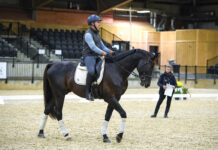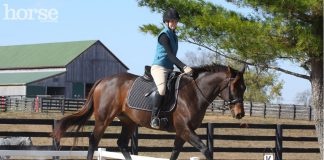Obviously, though, what you gain from trail training depends on how you tackle it. Notice first of all that I refer to it as trail training as opposed to trail riding. A lot of riders approach trails as a chance to meander along and enjoy the scenery. Others see it as a nerve-wracking experience filled with unwanted challenges. Neither of these approaches fosters the complement that trails can have on dressage and vice versa.
My first tip is exactly this: treat the trails as training, not a passive stroll through the countryside. Ride with the same attentiveness and expectations you have in the arena. Are your half-halts working? Can you ride several smooth transitions during a given stretch of trail? Is your horse stretching his neck nicely forwards and downwards? Ride with constant feeling and adjustments to rhythm, rein contact, and horse’s line of travel. Riding along with loose reins and a sloppy body position might seem relaxing but it counter-productive to the rest of your horse’s training. While tempting, do NOT become a passive rider during trail rides. Doing so risks missing the real value of these training settings. Below are my other top tips for improving your dressage by using trails.
Walk Wisely
When you are on a section of trail that necessitates walking, shift between three different gears—slow, medium, and fast. Rather than plodding along in an un-changing gait, ask your horse to change frequently between these three different gears. This way, you will not only keep him listening better to you but also help him use his hind legs more fluidly.
Wavy Lines
Make it a habit to bend your horse consistently left and right, even on narrow sections of trail. When horses follow their noses straight down the trail for too long, they get stiff through the bodies which then leads to traveling heavily on the forehand. Instead, ask your horse to ride mini-serpentine lines as you ride down straight section of trails or roads. Ask him to bend as precisely and fluidly as you would in the arena, allowing the width of the trail to dictate the size of your serpentine lines. Also learn to take advantage of any place you see a field or area where you can leave the trail to ride circles around a tree or other marker.
Learn Shoulder-In and Use it
Dressage riders sometimes tout shoulder-in as being the alpha and omega of gymnastic training. Its merits are vast for improving the horse’s balance and use of his hindquarters. Get in the habit of riding a few strides of shoulder-in on trails any time the footing is soft enough to allow the horse’s hoof to rotate slightly laterally. As with your serpentines above, shoulder-in will help you derive a much better gymnastic outcome than just following the horse’s nose straight down the trail.
Ride the Jog
Teach your horse to move in a slow trot with shorter, rhythmic steps at about 5-6 miles per hour. This will allow him to move efficiently and in balance over undulating terrain, uneven surfaces, and for sustained distances. Some riders get eager to move at full speed in trot, which often causes the horse to tighten his back and over-use his neck and front end muscles to pull himself down the trail. By jogging along slowly, he will better coordinate his body around turns, down hills, and through terrain changes without having to come down to a walk. This enables him to stay softer and swinging in his back, allowing his hind legs to flex more and carry weight.
Ride Downhill like a Balance Beam
When traveling downhill, the horse relies on eccentric muscle contractions (lengthening of the fibers while simultaneously tensioning), which are the same type needed for collected movements in dressage. The conditioning payoffs from riding down hills are irreplaceable. The caveat, however, is that your horse MUST travel straight with his hips and shoulders aligned. Most horses, favoring a weaker hind leg, will try to walk down hills by shifting their hips over to one side and getting crooked. Be vigilant keeping the horse straight like a ruler between your legs. By doing so, you will help him become more symmetrical and stronger while increasing the flexion of his hind limbs rather than confirming a crookedness or stiffness.
Any time your arena riding and your trail outings seem like very separate and distinct endeavors, take time to think how you can make their goals and outcomes more alike. In a complete training program, they should complement one another.
JEC ARISTOTLE BALLOU is the author of 101 Dressage Exercises for Horse & Rider.







good info
Horses are just like us, it is nice and feels good, to brake routine, and do something different.
Since dressage originated as an effective and empathetic way to train cavalry horses – and battles are NOT fought on level, groomed surfaces in an arena – it makes sense that dressage should help your horse in all types of situations on all kinds of terrain. Getting out of the arena is good for the mind and spirit of both horse and rider!